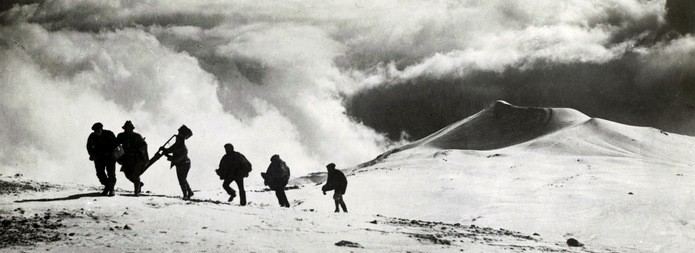The history of Etna Guides

The origins of guides on Etna are uncertain. The first accounts date from the end of the 18th century, when even then visitors were accompanied by guides who knew the secrets of the ‘Great Mountain’. Among them there are stories of a certain Biagio Motta, so-called ‘cyclops’, because of his stature, and who in 1776 was described by French traveller Roland de la Platiere like this:
“A tall man, about 50 years of age, a human in appearance, with a stern look of one who is venerated; he walked ahead with big steps, without saying a word and who responded briefly and accurately to every question…”
In general, these guides were shepherds, hunters and woodcutters who knew the paths of this vast and varied land. There were no regulations, so their services were impromptu and they had to demonstrate physical and moral abilities in order to gain the trust of the travellers who, as well as having a spirit of adventure, also had a good dose of prejudice, to the point that Brydone said; “We found the people that live on the mountain wilder and more uncivilised than we had ever seen before”, or as Eliseo Reclus said in his travel journal ‘Sicily and the eruption of Etna in 1865′ commented: “…for us there was also a high risk as strangers, that when we passed through Nicolosi we would be assaulted and robbed by beggars, guides and inn-keepers.
The most famous travellers, returning to their homeland, informed the great intellectual plateau of Northern Europe through their diaries, their experiences travelling through Italy together with news, curiosities and images drawn by their artists, sometimes slandering, but often exalting the natural beauty of Sicily, in particular Etna. Boasting the grandeur of the mountain with its eruptions and varied environment that only Etna can offer with woods so different in the forestry in three vegetation regions, ski areas formed by previous lava flows, deserts formed by lava and lapilli in the higher regions, the central crater with its eternal feather of smoke. They described villages growing clinging to its sides, rich in history, fighting continuously against the volcano. They described people who were versatile and intuitive, disobedient, fertile, stubborn and ready, who have been able to maintain a strange relationship of hate and love with this great mountain of fire.
Divulging this news, together with the blossoming of natural science and in the presence of the most famous volcanologists the “Gemmellaro brothers” a discreet number of travellers began to arrive, thus the need to create the first forms of accommodation and inns, and all that travellers coming to discover the volcano would need (shops, craftsmen etc.). So said Elisea Reclus in his report for the commodity and comfort that they offer.
Mario Gemmellaro, therefore, understanding the travellers needs when asking for the assistance of people able to accompany them had an idea and in 1804 organized a group of guides and muleteers, with expert knowledge of the dangerous paths around Etna.
The people who would then become guides were recruited by Gemmellaro who knew them personally for their physical capacity, moral reticence, honesty and knowledge of the mountain, guaranteeing them the prestige and safety that allowed them to look after travellers entrusted to them.
The guides, autonomously, chose the itineraries appropriate for their clients, judging by the number of participants and luggage, organizing porters for baggage transport. If the group left on foot from Nicolosi, the guides organized mules that could be ridden or used to carry baggage. Such services finished on arrival at the “Gratissima”, a small shelter for travellers at the base of the last cone along the road running up from Nicolosi.
The guides’ activities continued under the leadership of Gemmellaro and their successors for about 70 years.
In 1875 the first section of the Italian Alpine Club was founded. The management of this section was decided at the alpine congress, held at Domodossola in 1870, where the l’Abate Garret discussed the organization of guides and porters and the need for rules regarding the functions and tariffs. The main councillor, Orazio Spenna added such a proposal to the points to be discussed by the organization and the assembly decided to allow each section to decide for themselves based on their needs.
Therefore, in 1877, two years later, a set of rules and regulations for guides and porters for C.A.I. Catania section was decided. Thanks to the Italian Alpine Club the Nicolosi guides acquired their identity and are still known today as “Etna Guides”, also having the gratitude and thanks of more than two million visitors that during the last two centuries have been helped to discover the secrets of our great volcano.
In the same year the first group of guides and assistants was created, it was made up of people from the organization of Gemmellaro’s group, lately separated into two groups: the first named “Etna Guides” had the following members: Contarino Antonio (chief guide), Gemmellaro Giuseppe, Carbonaro Antonio, Consoli Salvatore, Anastasio Giuseppe, Costanzo Vincenzo, Leonardi Antonio, Leonardi Alfio, Gemmellaro Antonio, Galvagna Pietro, and Gemmellaro Salvatore, the only guides recognized suitable to accompany visitors in the higher regions of Etna and to the summit of the Central Crater. The other group named “Monti Rossi guides” which had these members: Salvatore Carbonaro (chief guide), Antonio Contarino, Gaetano Rizzo, Salvatore Chitè, Giuseppe Anastasio, Carmelo Chitè, and Nunzio Contarino, who guided visitors only until the summit of Monti Rossi. So ended the first period, the guides having now regulations together with a uniform, a cap and a special badge that permitted visitors to recognize the guides, their group and specialization. These later conformed with sections all over Italy.
At the moment, Etna Guides are the only people authorized to accompany visitors, regarding L.R. 28 of 6.04.1996, they are part of the regional Society of Sicilian Alpine and Volcanology Guides. Their main office is in via Etnea, 49 Nicolosi with 53 members of Alpine Guides, Alpine Emerited Guides and Volcano Guides.
Some of them, regularly enrolled in the registers or lists of the same college, operate singularly or associated, in cooperatives like ours which, today, are composed of mountain guides and volcanological guides.
